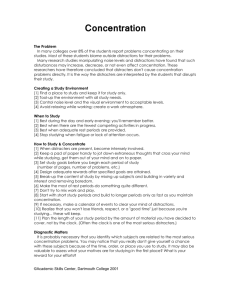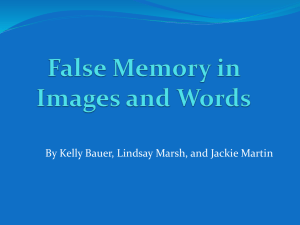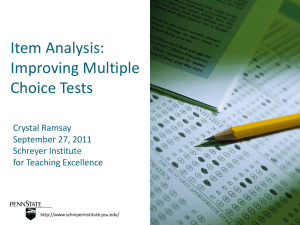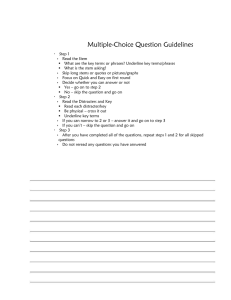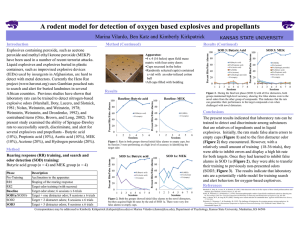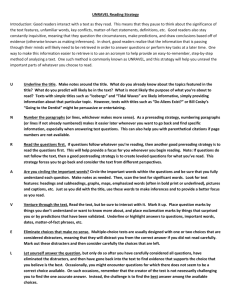Olfactory discrimination of oxygen based explosives and propellants by rats
advertisement
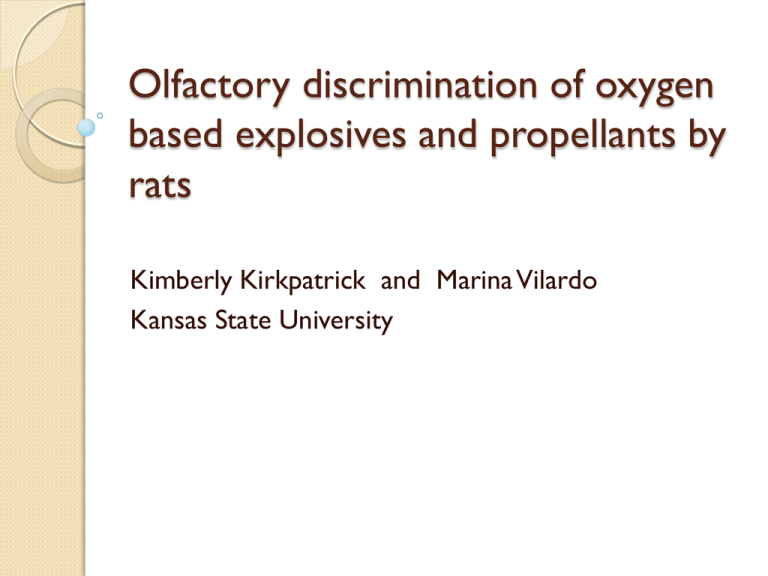
Olfactory discrimination of oxygen based explosives and propellants by rats Kimberly Kirkpatrick and Marina Vilardo Kansas State University Acknowledgments Marina Vilardo Dr. John Tomich Ben Katz Kansas State University HERO Rats (APOPO) Background Liquid explosives such as acetone peroxide have been used in recent terrorist attacks: ◦ London Underground bombing ◦ The Christmas Day bomber ◦ The Shoe-Bomber Liquid explosives have been used extensively in IED devices which have been responsible for countless deaths and injuries of American soldiers in Afghanistan and Iraq Non-nitrogen based explosives are difficult to detect through currently available electronic screening devices However, these explosives have characteristic odors that could be detected by trained animals Previous research Rats can readily detect nitrogenbased explosive odors (Marshall et al., 1981; Nolan et al., 1978; Weinstein et al., 1992) Rats can be trained to search and alert for odors associated with contraband items (Otto, Brown, and Long, 2002) Method: Apparatus Acid Group Butyric acid (BUT; 10%) Propionic acid (PRO; 10%) Acetic acid (AA; 10%) Ketone/Peroxide Group .. .. Methyl ethyl ketone (MEK; 10%) Acetone (ACE; 20%) Hydrogen peroxide (H2O2; 20%) General Method 8 Sprague-Dawley rats ◦ Acid group (n = 4) ◦ Ketone/Peroxide group (n = 4) Initial acclimation to apparatus Shaped to rear for sucrose+Nutella Reinforced for rearing to target Methods: Phase 1 Phase Description Baseline Target odor alone; 6 sessions x 6 trials [BUT or MEK] Target + one distracter odor; 8 sessions x 6 trials [Distracters from within group] Target + 2 distracter odors; 8 sessions x 6 trials [Distracters from within group] Target + 5 distracter odors; 8 sessions x 6 trials [Distracters from both groups] SOD1a/SOD1b SOD2 SOD5 Results: Phase 1 Baseline Percentage of "Hits" 100 80 60 40 BUT-EMPTY MEK-EMPTY 20 0 0 2 4 Session 6 Subsequent visits to empty cups < 1% Results: Phase 1 SOD1a Percentage of "Hits" 100 80 60 40 BUT-AA MEK-ACE 20 0 0 2 4 6 Session 8 Results: Phase 1 SOD1b Percentage of "Hits" 100 80 60 40 20 BUT-PRO MEK-H202 0 0 2 4 6 Session 8 Results: Phase 1 SOD 2 Perentage of "Hits" 100 80 60 40 BA-AA,PA 20 MEK-ACE,H2O2 0 0 2 4 6 Session 8 Results: Phase 1 SOD 5 Percentage of "Hits" 100 80 60 40 20 BUT-ALL MEK-ALL 0 0 2 4 6 Session 8 Acid Group Percentage of "Hits" or "FA" 100 80 60 40 BUT PRO AA 20 MEK ACE H2O2 0 0 2 4 Sessions 6 8 Percentage of "Hits" or "FA" Results: Phase 1 SOD 5 Ketone/Peroxide Group 100 80 60 40 MEK ACE H2O2 BUT PRO AA 20 0 0 2 4 6 Sessions 8 Methods: Phase 2 Phase Description Baseline Target odor alone; 6 sessions x 6 trials [AA or ACE] Target + one distracter odor; 8 sessions x 6 trials [Distracters from within group] Target + 2 distracter odors; 8 sessions x 6 trials [Distracters from within group] Target + 5 distracter odors; 8 sessions x 6 trials [Distracters from both groups] Target odor alone; 6 sessions x 6 trials [PRO or H2O2] Target + one distracter odor; 8 sessions x 6 trials [Distracters from within group] Target + 2 distracter odors; 8 sessions x 6 trials [Distracters from within group] Target + 5 distracter odors; 8 sessions x 6 trials [Distracters from both groups] SOD1a/SOD1b SOD2 SOD5 Baseline SOD1a/SOD1b SOD2 SOD5 Results: SOD 1a/1b Percentage of "Hits" 100 Acid Group * AA 80 PRO 60 40 BUT 20 0 AA-PRO BUT-AA BUT-PRO Target-Distracter Pair AA PRO BUT Results: SOD 1a/1b Ketone/Peroxide Group Percentage of "Hits" * * MEK .. .. 100 80 ACE 60 40 H2O2 20 0 MEK-ACE ACE-H2O2 MEK-H202 Target-Distracter Pair .. .. MEK H2O2 ACE Methods: Phase 3 During the previous phases, the rats experienced: ◦ Reinforcement in the arena ◦ Self-correction contingency Phase 3 tested the impact on performance ◦ Baseline – 2 days on SOD 3 [PRO or H2O2] ◦ Testing – 8 days on SOD 3 Rats were removed following first rearing response Reinforced if target, not reinforced if FA Results: Phase 3 Percentage of "Hits" 100 80 60 Baseline Test 40 20 0 PRO-ALL H2O2-ALL Summary and Conclusions Rats were able to learn to search and alert to specific targets ◦ Accurate discrimination performance: Emerged quickly Transferred readily to new distracters Rats were able to learn to search and alert to new targets that had been previously trained as distracters Summary and Conclusions Rats discriminated all target-distracter pairs to a high degree ◦ Acid group generalized most between AAPRO and AA-BUT ◦ Ketone/peroxide group generalized most between the two ketones While self-correction and/or reinforcement in the arena may have aided learning, they were not necessary for accurate performance Future directions Detection of oxidation ◦ H2O2 oxidizes rapidly ◦ Can rats detect oxidation? ◦ Relevant to detecting peroxide-based explosives (acetone peroxide) What is the threshold for detection? Addition of “rejection response”

